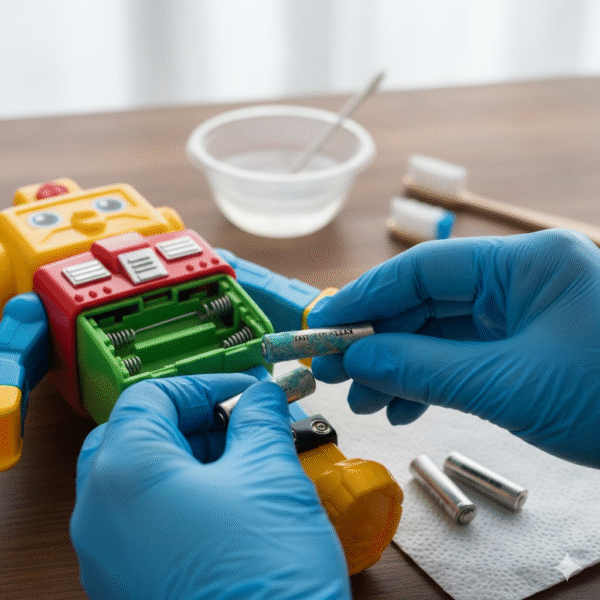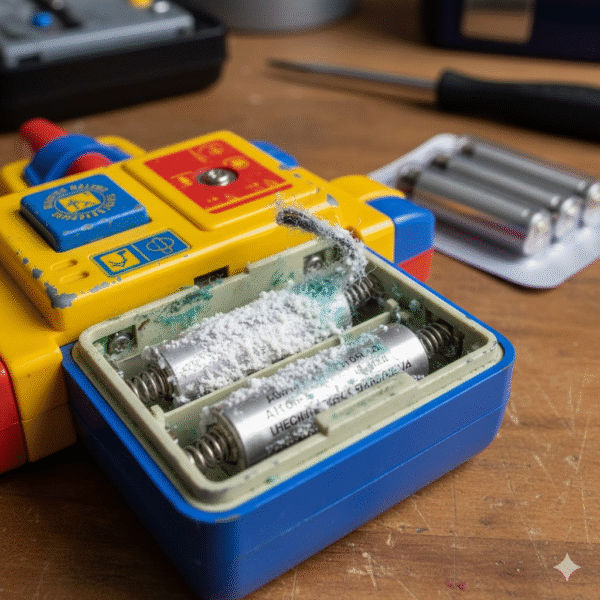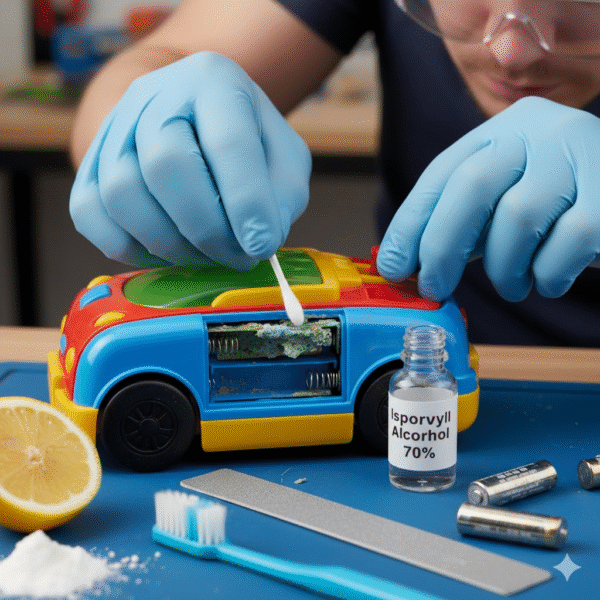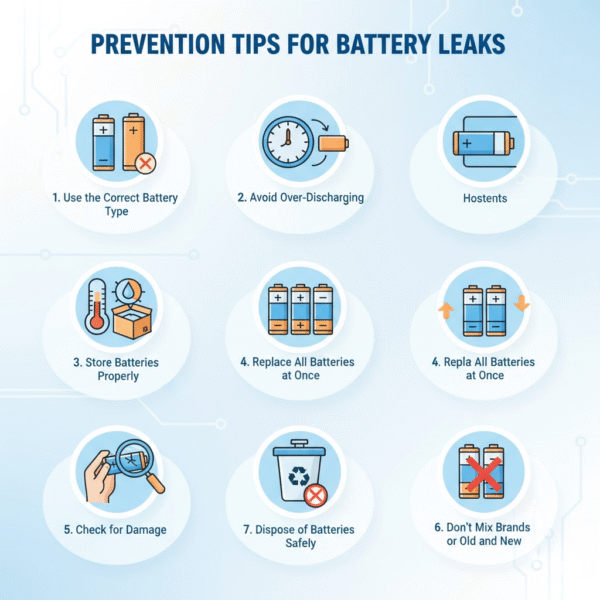Battery-powered toys bring joy to kids and collectors alike. But nothing stops the fun faster than discovering white or blue crusty buildup in the battery compartment. This is battery corrosion, often from alkaline battery leakage. If your doll, vintage electronic toy, or remote-control car has stopped working, you can likely fix it. Learning how to clean corrosion off battery terminals in toys is a simple DIY task. It uses items you already have at home, like vinegar or baking soda. This guide helps toy owners, collectors, and parents salvage their treasures without throwing them away.1

Many people search for “how to clean corrosion off battery terminals in toys” after finding a favorite toy silent. The good news? You do not need fancy tools or expensive repairs. With care, you can remove corrosion from toy battery terminals and get the toy working again. This method works for clean toy battery corrosion on springs, tabs, or contacts. It is safe for most plastics and electronics if you avoid water near circuits.
What Causes Battery Corrosion in Toys?
Battery corrosion happens when chemicals inside the battery leak out. Most toys use alkaline batteries, like AA or AAA. These contain potassium hydroxide, a base that turns into white or blue-green powder when it escapes.

Why does alkaline battery leakage occur? Common reasons include:
- Leaving batteries in unused toys for months or years.
- Over-discharging from low-quality or mixed batteries.
- Extreme heat or cold causing pressure buildup.
- Damaged battery casings from drops or age.
This leakage creates corroded contacts and rusted battery springs. It blocks electricity flow, making the toy stop. In vintage toys, battery compartment damage can ruin rare pieces. Collectors on forums like Reddit’s r/Dolls often share stories of blue deposits from “blue battery acid” – really potassium carbonate crystals.
Left alone, corrosion spreads. It can eat through metal springs or leak into circuits. But early action saves the day. Regular checks prevent battery leakage prevention issues.
Safety Steps Before Cleaning
Safety first – battery residue irritates skin, eyes, and lungs. Potassium hydroxide is caustic, not acidic like car batteries.
Follow these steps:
- Work in a well-ventilated area, away from kids and pets.
- Wear disposable gloves and safety glasses.
- Turn the toy off and open the compartment outside if possible.
- Remove leaked batteries carefully. Place them in a sealed plastic bag for hazardous waste disposal.
- Do not touch residue with bare hands.
- Keep a trash bag handy for soiled tools.
If corrosion touches skin, rinse with water for 15 minutes. For eyes, flush and seek medical help. These precautions make safe toy repair tips easy.
Tools and Materials You Need
Gather these household items for household cleaning solutions for corrosion:
- White vinegar (mild acid for alkaline residue).
- Baking soda (for paste on stubborn spots).
- Cotton swabs (Q-tips) or soft toothbrush.
- Isopropyl alcohol (70% or higher) for final rinse.
- Paper towels or lint-free cloth.
- Small bowl for mixing.
- Optional: Pencil eraser for light polishing, petroleum jelly for protection.
No need for harsh chemicals. These are cost-effective for DIY corrosion removal.
Step-by-Step Cleaning Process
Ready to fix battery corrosion in toys? Follow this step-by-step guide to clean toy battery corrosion.2
Step 1: Remove Loose Debris
Tap the toy gently over a trash bin to shake out powder. Use a dry cotton swab to wipe loose flakes. Avoid blowing – it spreads residue.
Step 2: Neutralize with Vinegar
Vinegar excels at battery acid neutralization for alkaline leaks.
- Dip a cotton swab in white vinegar.
- Dab onto corroded contacts and springs.
- Watch it fizz – that’s the reaction breaking down residue.
- Scrub gently with a soft toothbrush for rusted battery springs.
- Repeat until no more fizzing.
Vinegar dissolves the white crust without harming most plastics.
Step 3: Use Baking Soda for Stubborn Spots
For heavy buildup, make a paste.
- Mix 1 tablespoon baking soda with a few drops of water.
- Apply to terminals with a swab.
- Scrub lightly – its mild abrasion helps toy battery acid cleanup.
- Wipe away paste with a damp cloth.
The vinegar and baking soda cleaning method combines acid and base for thorough results. Use vinegar first, then baking soda if needed.
Step 4: Rinse and Dry
- Wipe with a cloth dampened in water (sparingly – no soaking).
- Follow with isopropyl alcohol on a swab to displace moisture.
- Let air dry completely, at least 1-2 hours. Use a fan for faster drying.
Alcohol ensures no residue causes future corroded contacts.
Step 5: Polish and Protect
- Rub contacts with a pencil eraser for shine.
- Apply a thin layer of petroleum jelly to prevent oxidation.
Step 6: Test the Toy
Insert fresh batteries (same type and brand). Turn on – it should work! If not, corrosion may have damaged wires. Check for battery terminal damage in toy.
This process restores most toys. For restore corroded battery terminals toy, it beats buying new.3
How to Fix Corroded Toy Battery Contacts
Severe cases need extra care for how to fix corroded toy battery contacts.

- If a spring broke, bend a paperclip or foil strip as a replacement.
- For deep rust, use fine sandpaper (gently) on metal parts.
- Avoid water near buttons or speakers.
Collectors fix vintage dolls this way, saving toy electronics maintenance costs.
Examples: One parent cleaned a talking doll with vinegar Q-tips – it spoke again! A hobbyist revived a 90s Furby using baking soda paste.
Prevention Tips for Battery Leaks
Stop problems before they start with battery leakage prevention.

- Remove batteries from stored toys.
- Use high-quality brands – avoid mixing old/new.
- Check compartments every 3-6 months.
- Store in cool, dry places.
- Consider rechargeables for frequent use.
These toy maintenance and repair habits extend life. No more “toy battery compartment corrosion fix” emergencies.
Common Mistakes to Avoid
- Using water alone – it spreads residue.
- Scrubbing too hard – damages plastics.
- Skipping drying – causes new corrosion.
- Reusing leaked batteries – dangerous.
When to Replace the Toy
If cleaning fails or plastic melted, salvage parts. For collectors, seek repair battery terminal damage in toy pros.
FAQs About Cleaning Toy Battery Corrosion
Is battery corrosion dangerous?
Yes, it irritates skin. Always wear protection.
Can I use lemon juice instead of vinegar?
Yes – it’s a mild acid for neutralizing alkaline residue.
What if the toy has NiCad batteries?
Rare in toys; use vinegar still.
How to clean battery leaks in toys fast?
Vinegar Q-tip method takes 10 minutes.
In Conclusion
You now know how to clean corrosion off battery terminals in toys safely and effectively.4 From understanding causes to using vinegar or baking soda, this guide covers it all. Save money, reduce waste, and keep playtime going. With prevention, your toys stay corrosion-free.
Have you revived a toy this way? Share your story below!
References
- he Spruce. “How to Clean Battery Corrosion.” thespruce.com, 2022. https://www.thespruce.com/how-to-clean-battery-corrosion-5073244 (General safety; broad audience including toy owners.) ↩︎
- Tru Earth. “How to Clean Battery Corrosion in Toys.” tru.earth, 2023. https://tru.earth/blogs/tru-living/how-to-clean-battery-corrosion-in-toys (Step-by-step for child safety; targets eco-conscious parents.) ↩︎
- Andrea Dekker. “How to Clean Battery Corrosion: A Simple 6-Step Process.” andreadekker.com, 2020. https://andreadekker.com/clean-battery-corrosion/ (Details vinegar for alkaline leaks in toys; audience: parents fixing kids’ items.) ↩︎
- iFixit. “SOLVED: How to clean battery terminal corrosion – Furby.” ifixit.com. https://www.ifixit.com/Answers/View/148665/How%2Bto%2Bclean%2Bbattery%2Bterminal%2Bcorrosion (Vintage toy example; hobbyists repairing collectibles.)
Reddit r/Dolls. “Battery corrosion fixable?” 2023. ↩︎